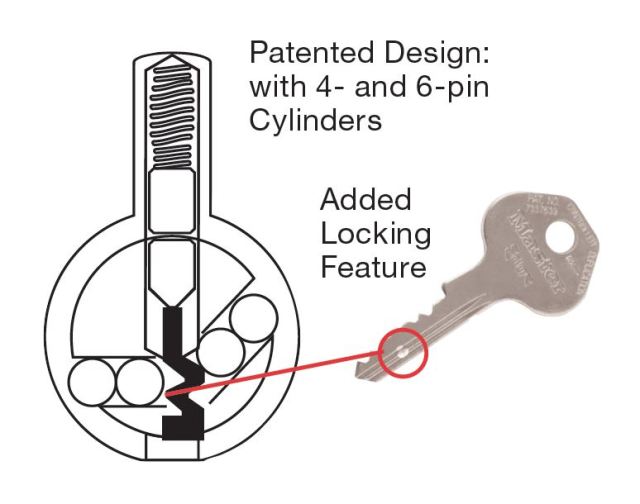EDGE® Key Control System – Master Lock Company Cylinder Innovation

Have you found yourself wondering: How did the Master Lock Company come up with the EDGE® Key Control? First we have to go back a little ways to see how we got to where we are today with keyed lock and padlock security. Lets focus on the main 3 tumbler locks that all paved the way for lock cylinders that make keying alike possible.
The modern Pin Tumbler Lock, invented by Linus Yale Sr. in 1848, was conceptually based on the old Egyptian style door lock dating back to 4000 BCE. This early door lock consisted of a wooden bolt with vertical holes secured to the door frame with pins holding the bold in place. Without a key to raise the pins to an appropriate height to unlock the door, this bolt prevented the door from being opened. In 1861, Linus Yale Jr. innovated his fathers design which incorporated varied pin lengths to accept a smaller flat key with a serrated edge. This innovation is still the basis for pin tumbler locks to this day.
The Wafer Tumbler Lock, patented by Philo Felter in 1868, uses flat wafers and a matching flat double-bitted steel key or ‘feather key’. It was called a ‘feather key’ because of the considerable, feather like, difference from many of the heavy bit keys of the time. The wafer tumbler lock was manufactured in Cazenovia, New York by Philo Felter’s American Lock Manufacturing Company. Eventually, by 1978, Yale Lock purchased the American Lock Manufacturing Company from Felter.
The Disc Tumbler Lock was invented in 1907 by Emil Henriksson, a Finnish mechanic. The disc tumbler lock uses a very similar locking mechanism to a dial combination lock, only instead of the dial combination the lock uses keyed access. Through the use of detainer discs and a matching cut key specific to the discs this style of lock cylinder is highly secure. Disc tumbler locks are commonly used with cam locks to secure cash drawers, Finnish household doors, file cabinets, lock boxes and tool boxes.
While the wafer tumbler lock and disc tumbler lock sound like they operate similarly, they each function through different locking mechanism.
These modernizing innovations, of their time, have all helped pave the way for modern lock cylinders. Based on the pin tumbler, the Master Lock EDGE® Key System cylinders patented innovation includes a secondary locking mechanism using ball bearing on each side of the keyway. The Ball bearings create a virtual keyway for the key control system, in addition to the actual keyway for the double warded keys specific to the EDGE® Key System cylinders. In the EDGE® Key System like any other key system, the cylinders allow for door locks and padlocks to be keyed alike or more easily rekeyed.

Would you believe that the Master Lock® Python™ cylinder uses a disc tumbler mechanism? It is the only one of the Master Lock Company 10 basic cylinder sizes/types that is not based on the pin tumbler lock. That topic will be covered in the next blog.
“Master Lock Company Makes ten basic cylinder sizes/types for use in our padlocks:”
- Small diameter cylinder (pin tumbler lock)
- Four pin cylinder
- Five pin cylinder
- Six pin cylinder
- W19 cylinder
- Interchangeable Core (IC) cylinders
- Door hardware cylinders
- Master Lock EDGE® System cylinders
- Python™ cylinder
- Universal Pin (UP) cylinder


